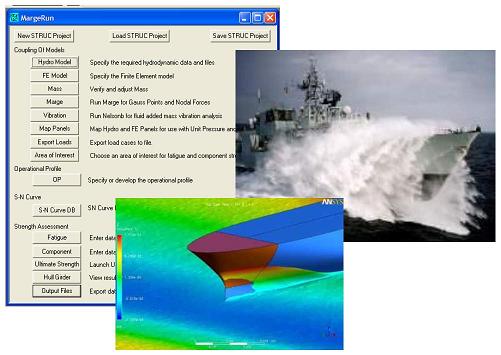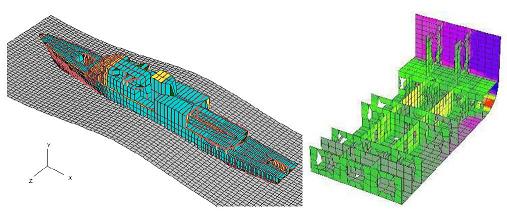Structural Assessment Including Nonlinear Aspects
Backgrounds
The SANE project was initiated to continue investigation of leading-edge structural load and response issues for ships. It builds on earlier STRUC and STRUC2 projects.
The first CRS project on ship structures was completed in 2005. The STRUC project focused on producing a software tool to be used in conjunction with PRECAL for defining ship structural loads for fatigue and ultimate strength assessment. The STRUC software consists of the following modules for reading and checking the PRECAL hydrodynamic data, reading and checking a finite element ship model, comparing/modifying the hydro and structure hull form and mass, developing the unit load hydro/structure loads interface, facilitating the unit load structural calculations, defining sea loads through specific ship operations and statistics, making corrections for certain nonlinear hog/sag cases, calculating the ultimate stress on specific ship components, and calculating the stress exceedance curves and stress-cycle distributions for input to fatigue calculations.
The STRUC2 project has addressed subjects in nonlinear loads, improved hydro/structure interfaces, sensitivities of ship operational parameters, strength and durability calculations, 3D time domain structural calculations, software upgrades and validation.
The result of these projects is a comprehensive structural loads and response software tool called STRUC. The tool has been tested and validated for a number of full 3D case studies on different types of ships. While all of these functions have been implemented and tested to some degree, not all of them have been validated or are optimized for user functionality.

Objectives
The three-year SANE project was accepted at the CRS 2009 AGM funded at 400k€. The main objectives of SANE are to increase user functionality in the above technical areas, extend the validation and the robustness of the STRUC software, take advantage of recent developments in PRECAL and PRETTI for defining nonlinear structural loads, and to include a Finite Element Solver in the STRUC software.
1. Nonlinear Load Effects: This will extend work done under STRUC and STRUC2, in particular hydro-elastic effects through modal analysis, effects of slamming and other nonlinear load effects on fatigue, and inclusion of Response Conditioned Waves. This is ground-breaking research work in trying to include nonlinear load effects in structural response calculations.
2. Finite Element Solver and Enhanced Capabilities: The VAST (Vibration and Strength) finite element analysis code for marine structures will be seamlessly integrated into the STRUC software for linear structural strength, full-ship wet and dry natural frequency and mode shape calculations, and static and dynamic analysis with linear and nonlinear wave loads. Links to other FE packages will also be improved through the FEMAP software. A top-down modelling capability will be incorporated to efficiently model the transfer of global loads on full-ship finite element models to computation of the structural response on local detailed models for fatigue analysis.
3. Validation and Sensitivity Analysis: STRUC and STRUC2 saw a rapid expansion of state-of-the-art methods for applying various sea loads to structural analysis models. These were validated to some extent but a more extensive validation effort is required as well as expanded sensitivity studies to look at various operational parameters such as mass distribution on structural response.
4. Other Topics: Several additional topics will be addressed including improvements to fatigue calculations and an investigation of limit state analysis.
Expected Results
Delivery of an updated and validated STRUC Structural Loads software tool with an integrated finite element (FE) solver for fatigue and ultimate strength assessment of ships using full ship FE models and detailed local models subject to sea loads defined by voyage and lifetime operational profiles.

